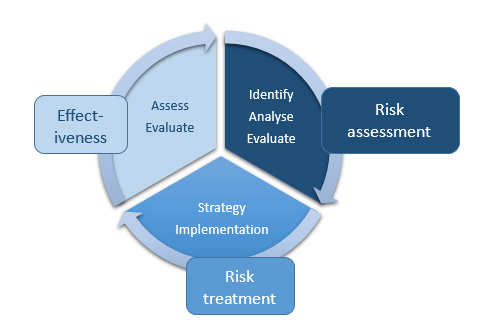The annual planning of control activities agreed in JDPs coordinated by EFCA is based on a risk management process. Different types of information and data are compiled and analysed to formulate recommendations for the cost-effective deployment of control means and implementation of activities to monitor and improve compliance. The risk assessment exercise aims to define the level of risk of non-compliance associated with each fishery segment, which is defined according to the type of fishing gear, the geographical area and the target species. Based on this assessment, a set of recommendations on priority risks is agreed, which will be the basis for the development of JDPs.
What is the risk management process?
A risk management process consists of a structured framework for the identification, analysis, evaluation and treatment of risks. The aim of the process is to contribute to the efficient placement of inspection and control means in order to respond to risks, to create effective deterrence to non-compliance and to provide assurance that compliance risks are recognised and addressed in a systematic way. The framework also incorporates an effectiveness analysis, to improve future risk management cycles.
The regional risk management process conducted by EFCA is aligned with the generic risk management methodologies, such as the ones applied for natural hazards or financial risks. The aim is to make the most of the limited resources of inspections means.
Risk management is composed of three main steps:
A. Risk assessment. This is the process where the main risks of non-compliance are identified, analysed and evaluated. The analysis consists in estimating two factors: (a) impact or consequences of non-compliance threats to the common fisheries policy objectives and (b) the likelihood that those threats will occur, based on intelligence or compliance indicators developed by EFCA with Member States. Each risk is evaluated based on these two factors, leading to a categorisation of the fleet segment having a low, medium, high or very high risk of each identified threat.
B. Risk treatment. This step aims to select and implement effective counter-measures adapted to a cost-effective use of available resources. Risk treatment measures should address risks considered as not acceptable. Several aspects should be considered when recommending a given risk treatment strategy, such as the current level of control, the cost-effectiveness of the recommended actions, the deterrence effect, available resources, etc. In general, low-priority risks are monitored, while specific plans are developed and implemented for high-priority risks.
C. Effectiveness analysis. A critical examination of the process is an important step in the full cycle of the risk management process. This step enables an evaluation of the framework itself and the effectiveness and efficiency of the risk treatment measures implemented. An annual JDP assessment report is produced annually for each JDP area.

